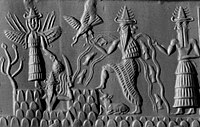Gallu

| Part of a series on |
| Ancient Mesopotamian religion |
|---|
 |
|
|
This article needs additional citations for verification. (September 2010) |
In Sumerian and ancient Mesopotamian religion, gallûs[1] (also called gallas[2]; Akkadian gallû < Sumerian gal.lu) were great demons or devils of the ancient Mesopotamian Underworld.
Role in mythology
Gallu demons hauled unfortunate victims off to the underworld. They were one of seven devils (or "the offspring of hell") of Babylonian theology that could be appeased by the sacrifice of a lamb at their altars.[3]
The goddess Inanna was pursued by gallu demons after being escorted from the Underworld by Galatura and Kuryara.[4][3] An especially fierce gallu demon, the monstrous Asag, was slain by Ninurta using the enchanted mace Sharur.
Other uses
The word gallu may also refer to a human adversary, one that is dangerous and implacable.[5]
See also
References
- ^ Morris, John (1880). The new nation. Original from Oxford University. pp. 40 & 311 (volume 3 of 5).
{{cite book}}: CS1 maint: location missing publisher (link) - ^ Muss-Arnolt, William (1905). A Concise Dictionary of the Assyrian Language. Original from Harvard University: Reuther & Reichard; Lemcke & Büchner; etc., etc. p. 216.
{{cite book}}: Cite has empty unknown parameter:|coauthors=(help) - ^ a b Essays in Modern Theology and Related Subjects. Original from Harvard University: C. Scribner's sons. 1911. pp. 155–158.
{{cite book}}: Cite uses deprecated parameter|authors=(help) - ^ Black, Jeremy; Cunningham, Graham; Flückiger-Hawker, Esther; Robson, Eleanor; Taylor, John; Zólyomi, Gábor. "Inana's descent to the netherworld". Electronic Text Corpus of Sumerian Literature. Oxford University. Retrieved 22 June 2017.
- ^ I. Tzvi Abusch Babylonian Witchcraft Literature: Case Studies 1987 "...especially, the initial position which he occupies in both support the propriety of our earlier analysis of obv. 37-40 on the basis of the comparison "Contra AHw sv, gallu in this line refers not to a demon but to a human enemy..."

